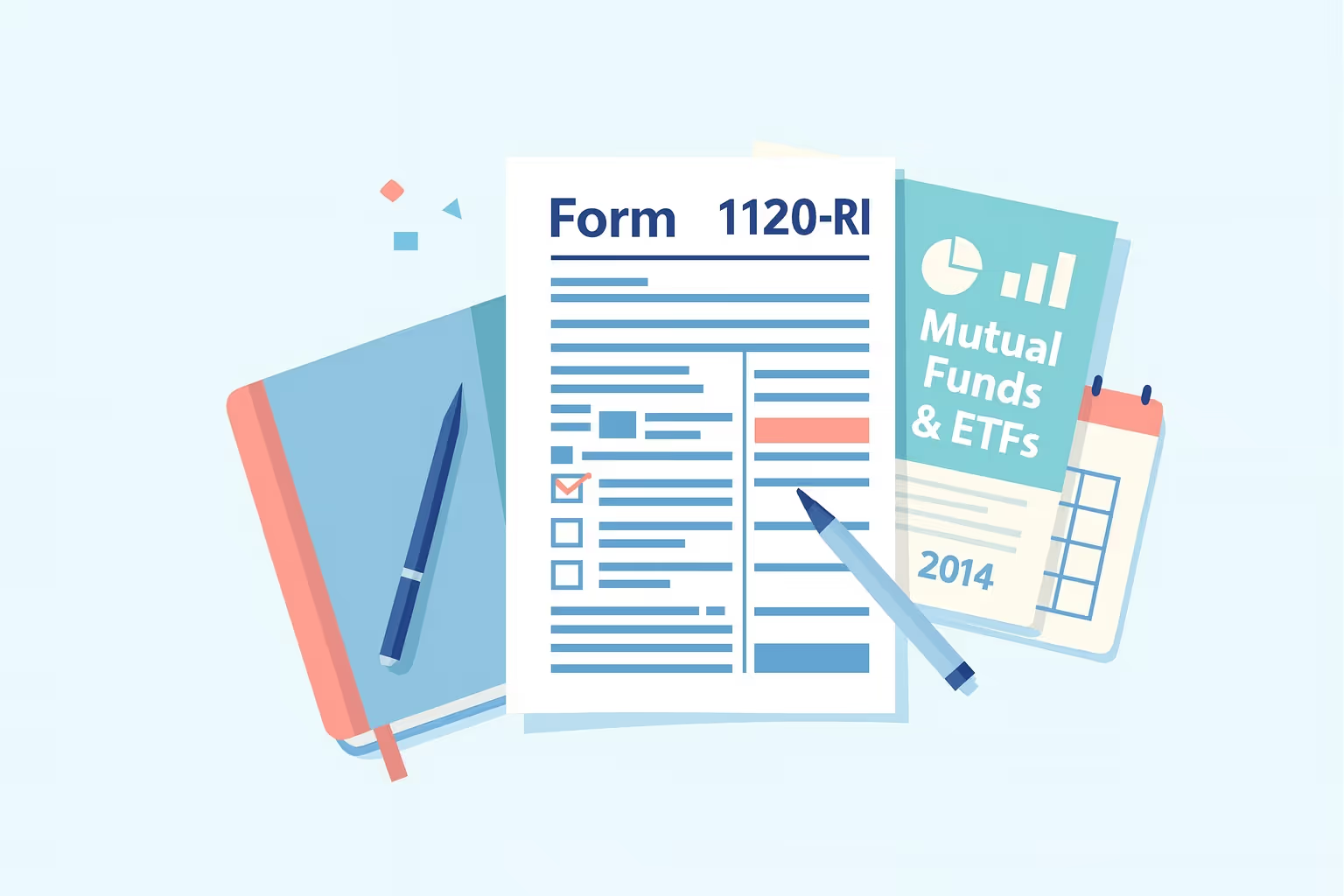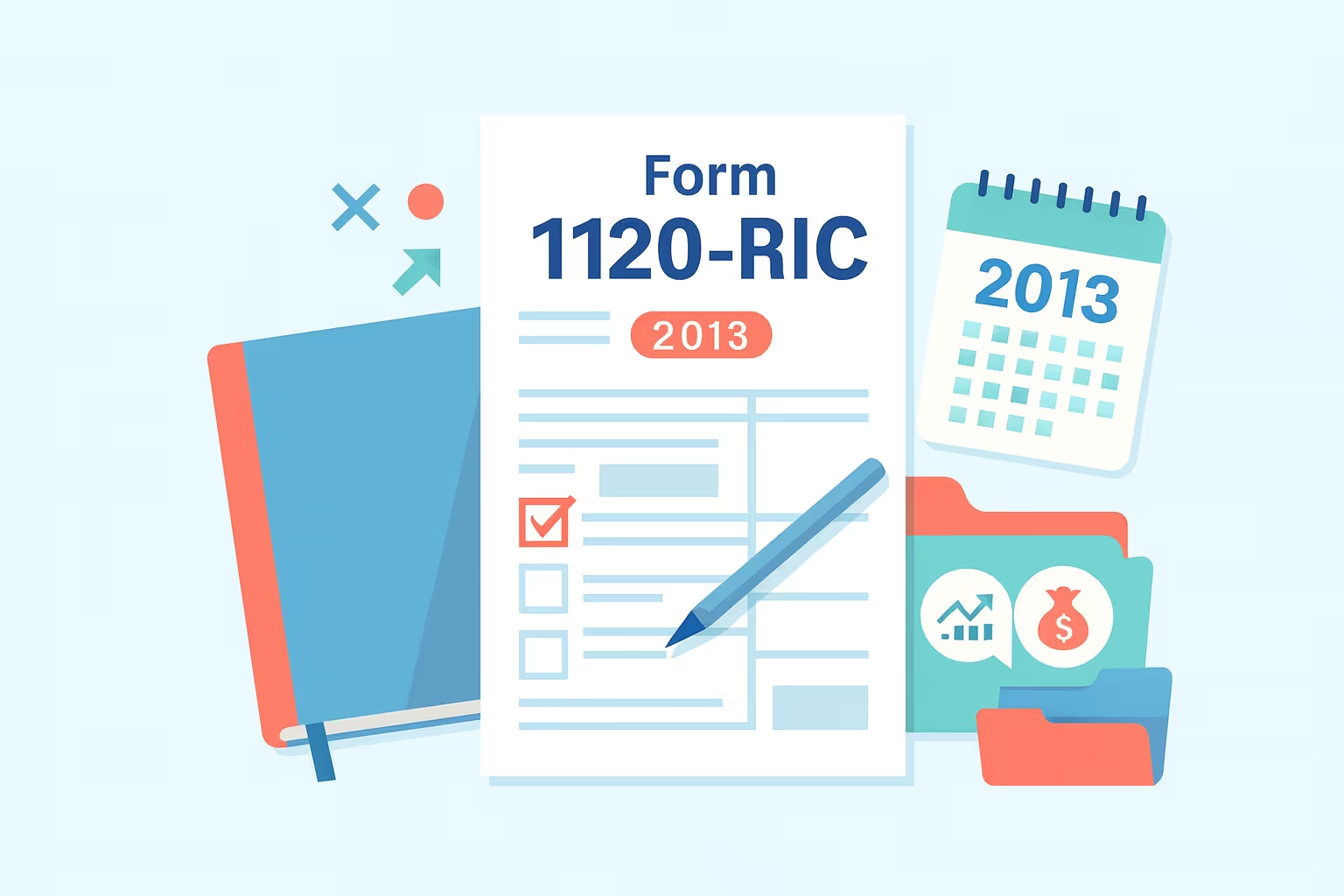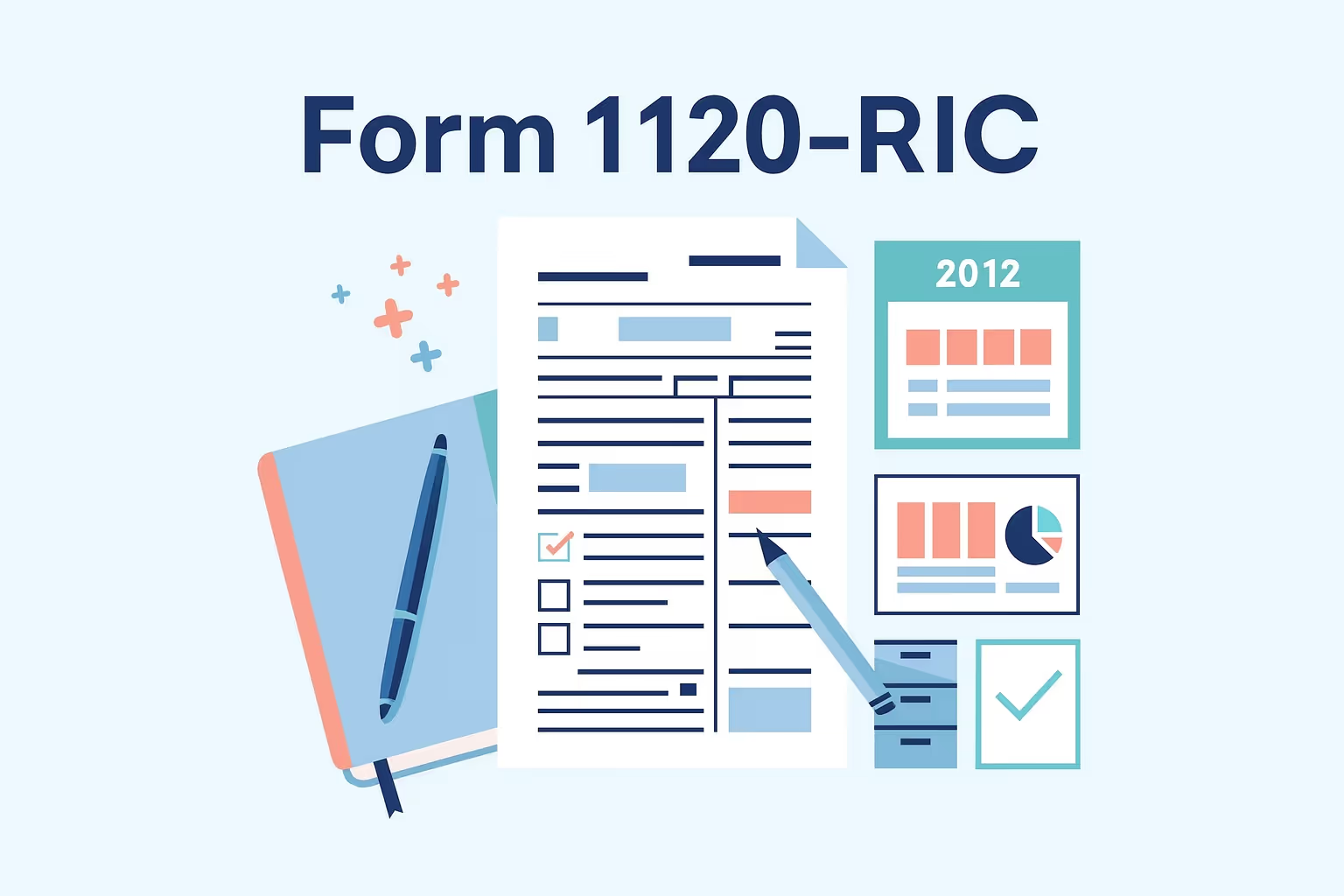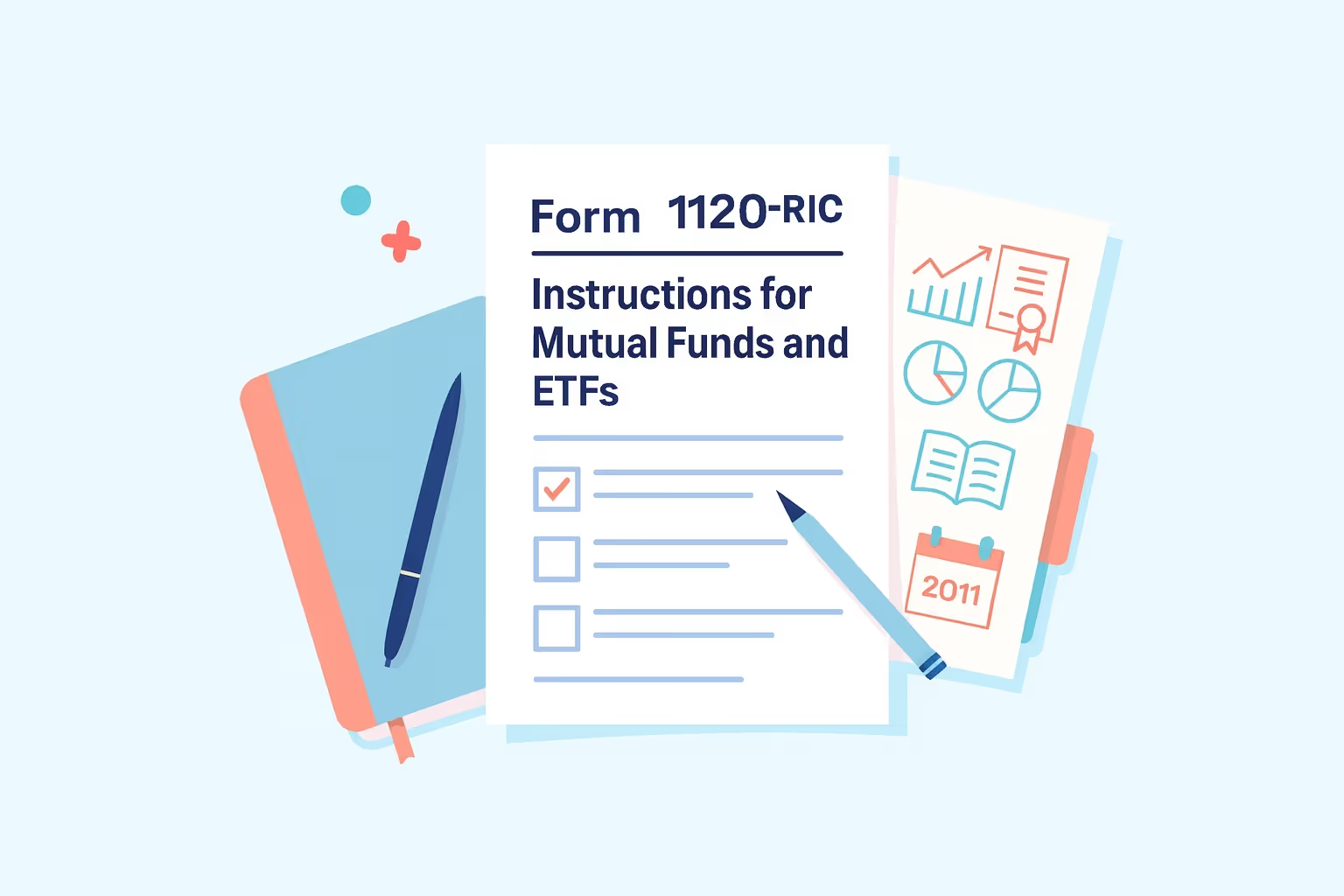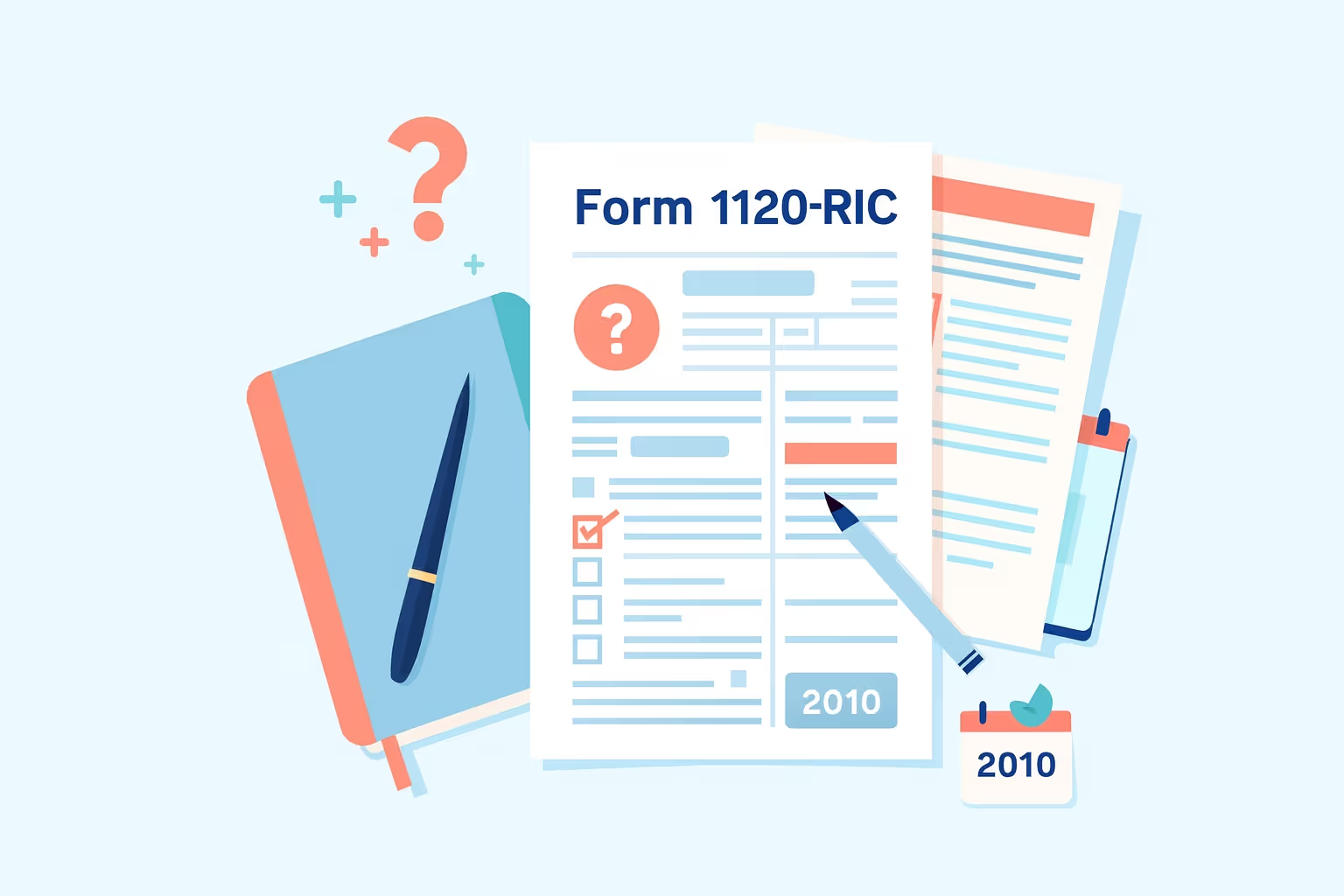
The IRS reports that penalties for late filing of certain corporate returns in 2025 can reach a minimum of $510 if the return is over 60 days overdue. For regulated investment companies (RICs) filing Federal Form 1120-RIC for Tax Year 2024, that figure underscores how quickly costs escalate when deadlines are missed. Beyond penalties, delays in claiming deductions or distributing taxable income can harm shareholder returns and disrupt cash planning.
Form 1120-RIC is the corporation income tax return used by mutual funds, ETFs, and other RICs that elect this special tax status. Unlike a standard Form 1120, it calculates investment company taxable income, applies the dividends paid deduction, and reports compliance with strict qualification tests. Failing to complete the form accurately could result in losing RIC status, facing double taxation, or triggering excise tax liability. These risks make timely and accurate filing more than just a compliance exercise; it is a financial safeguard.
This guide provides a step-by-step roadmap for Federal Form 1120-RIC for Tax Year 2024. It explains how to prepare schedules, handle estimated tax payments, and avoid common errors that delay refunds or increase federal income tax liability. We will emphasize why early filing, electronic submission, and careful recordkeeping are essential. Don’t let easily avoidable errors cost your fund hundreds in penalties or weeks in processing delays.
Federal Form 1120-RIC: Who Must File and What Counts as a RIC
Confirming whether your entity qualifies as a regulated investment company (RIC) is essential before completing schedules or computing taxable income. Filing the wrong form or misunderstanding eligibility rules can lead to rejected returns, penalties, and even loss of preferential tax treatment.
Who files this income tax return?
- A domestic corporation elected to be treated as a regulated investment company must file Federal Form 1120-RIC for Tax Year 2024. The election is made simply by calculating the investment company's taxable income under RIC rules and submitting this return on time.
- Real estate investment trusts, life insurance companies, and casualty insurance companies cannot file Form 1120-RIC. These entities use other specialized forms, and separate provisions of federal tax law govern the tax imposed on them.
Key definitions that affect tax liability
- Taxable income on Form 1120-RIC is determined before the dividends paid deduction. This deduction is crucial for eliminating most corporate-level federal income tax but requires accurate records of dividend declarations, record dates, and payments.
- Gross income for a RIC includes dividends, interest, securities loans income, capital gains, and net foreign currency gain. Exclusions and special deductions apply, but each adjustment directly affects total tax and future estimated tax payments.
What Changed for Federal Form 1120-RIC for Tax Year 2024
Tax rules for regulated investment companies evolve yearly, and 2024 introduces changes that can directly impact filing strategies. Knowing these updates before preparing your corporation income tax return will help reduce errors and avoid costly penalties.
Penalties, due dates, and e-file signals
- The minimum penalty for failing to file a return more than 60 days late has increased to $510 or the amount of tax due, whichever is smaller. This higher floor makes missing the deadline particularly expensive, even for smaller funds with limited activity.
- Estimated tax penalty rules continue to apply. Funds must make accurate quarterly estimated tax payments to avoid quickly accumulating charges. E-file remains the preferred method: it provides validation checks, faster acknowledgments, and shorter refund timelines than paper submissions.
Addresses, electronic mandates, and attachment sequencing
- The Internal Revenue Service requires filers to confirm the correct processing center address, which depends on total assets and principal office location. Using an outdated address can delay processing and increase IRS correspondence.
- Returns filed on paper must follow the precise attachment order. When filed electronically, software validation ensures that required forms and schedules are included, reducing rejections and amendments.
Pre-Filing Checklist
Preparation is often the most time-consuming part of completing an income tax return. A well-organized pre-filing checklist ensures that all essential records are ready before you begin entering amounts on Form 1120-RIC.
Identification; accounting; and governance
- Confirm your corporation’s legal name, Employer Identification Number, and any address or name changes. Minor discrepancies can trigger IRS notices or delay refund processing. Maintain updated records with your custodian and registered agent.
- Verify the accounting method and confirm whether the entity operates on a calendar or fiscal year. Board meeting minutes should document dividend approvals, investment advisory fees, custodian fees, and all supporting deductions.
Financial statements and supporting evidence
- Prepare a year-end income statement, balance sheets, and a trial balance. Reconcile these with brokerage statements to ensure that reported capital gains and gross receipts align with actual transactions.
- Assemble records supporting foreign taxes, securities loans, income, and business interest expense. Retain copies of Form 1099-DIV, Form 1099-INT, and related confirmations. Registration fees, accounting services, and legal services invoices should also be appropriately categorized for deduction reporting.
Completing this checklist reduces the risk of missing documentation later. Once these items are in place, filling out the form becomes significantly smoother.
Completing Federal Form 1120-RIC for Tax Year 2024
Once the supporting documents are gathered, the next stage is carefully filling out the form. Each part of Federal Form 1120-RIC for Tax Year 2024 connects to taxable income, credits, and final tax liability, so accuracy is essential.
Header, check applicable boxes, and accounting period
- Enter the corporation’s full legal name, Employer Identification Number, address, and the tax year dates. Check applicable boxes if the return is final, amended, or reflects a name or address change. These entries determine processing accuracy.
- Report total assets at year's end. This figure affects where the return is filed and may influence whether the IRS assigns the case to the Large Business & International division.
Part I – Investment company taxable income
- Report gross receipts, dividends, interest, and other source income. Deduct allowable expenses, including salaries, interest, depreciation, accounting, and legal services.
- List “other deductions” on a supporting schedule. These often include custodian fees, investment advisory fees, and registration fees. Precise categorization supports both compliance and audit readiness.
Part II – Tax on undistributed net capital gain
- Calculate the additional tax imposed if net capital gains are retained instead of distributed. Weigh whether declaring capital gain dividends provides a more favorable outcome for shareholders.
- If applicable, evaluate built-in gains tax interactions and reconcile to Schedule D totals for capital transactions.
Schedule A – Deduction for dividends paid.
- Report ordinary, capital gain, and exempt-interest dividends. Late-year declared dividends paid in January also qualify if the rules are met.
- Verify dividend amounts against transfer agent and shareholder records. Reinvested dividends must also be reconciled to prevent overstatement or understatement.
Schedule B – Income from tax-exempt obligations
- Report income from tax credit bonds and municipal securities. Adjust for any disallowed related interest expense.
- Exclude income categories that are not federally exempt, such as certain private activity bonds. Supporting broker confirmations are necessary.
Schedule J – Tax computation, credits, and payments
- Calculate federal income tax, apply foreign taxes through Form 1118, and include any general business or employment credits.
- Reconcile estimated tax payments, federal tax paid through EFTPS, and extension payments. The final calculation shows either tax due or overpayment.
Schedules K, L, and M-1
- Complete Schedule K by answering questions on foreign corporations, controlled group membership, and securities loans.
- Present balance sheets on Schedule L and reconcile book income to taxable income on Schedule M-1. These schedules demonstrate transparency and accuracy to the IRS.
Filing Methods for Federal Form 1120-RIC: E-File vs Paper
Once the form is complete, the next step is submission. Choosing between electronic and paper filing directly affects timing, accuracy, and audit risk. Most regulated investment companies benefit from e-file, but paper submission is still available when necessary.
Why electronic filing is strongly preferred
- Electronic filing reduces the likelihood of rejection caused by missing schedules or misordered attachments. IRS-approved software validates calculations and requires completion of mandatory fields before transmission.
- Processing is faster with e-file. Refunds tied to federal tax paid are often received in as little as 30 days, compared to eight weeks or longer for paper returns. This faster turnaround can free up cash for distributions or reinvestment.
Paper filing workflow when e-file is unavailable
- Paper submission should only be used if e-file systems reject the return repeatedly or if exceptional circumstances prevent electronic submission. Returns must be assembled in the official order, including all supporting schedules and signed pages.
- Always mail the return to the correct Treasury Internal Revenue Service processing center based on the company’s total assets and principal business location. Use certified mail with tracking to prove the filing date and reduce penalty disputes.
Payments and Penalties for Federal Form 1120-RIC (2024)
Handling cash obligations correctly is as important as filing the return itself. Late or insufficient payments can lead to penalties that grow quickly, even when the return is filed on time.
Paying federal tax and extensions
- Most RICs must pay electronically through the Electronic Federal Tax Payment System (EFTPS). Schedule payments no later than 8 p.m. Eastern Time the evening before the due date, and save confirmation numbers. Reconcile the bank statements immediately.
- Filing Form 7004 extends the time to file, not the time to pay. To avoid interest charges and penalties, estimate your tax liability carefully and submit payment with the extension request.
Quarterly estimated tax payments
- Calendar year RICs must make quarterly estimated tax payments in April, June, September, and December. Safe harbor rules allow you to pay either 100 percent of the prior year’s total tax or 90 percent of the current year’s projection.
- Market volatility often changes realized capital gains and dividends. Review estimates monthly to avoid an unexpected estimated tax penalty, and document adjustments in case the IRS questions payment timing.
Failure-to-file and failure-to-pay penalties
- Failure-to-file penalties are steep: if a return is more than 60 days late, the minimum penalty is $510 or the amount of tax due, whichever is smaller.
- Failure-to-pay penalties accrue monthly, typically at 0.5 percent of the unpaid amount—interest compounds on top of the penalty. Relief may be available if you can demonstrate ordinary business care and prudence, but you must provide supporting documentation.
Required Schedules and Attachments for Federal Form 1120-RIC
The IRS expects all schedules and attachments to be submitted in a specific sequence. Ignoring this order can slow down processing and increase the chance of receiving notices.
Mandatory attachments after page four
- Attach Schedule D (Capital Gains and Losses) and Form 8949 for sales and dispositions. Include Form 1118 if foreign taxes are claimed, and Form 8613 if excise tax applies.
- Add additional schedules in alphabetical order and extra forms in numerical order. Supporting statements, such as “other deductions” details or dividend reconciliation, should be clearly labeled and cross-referenced to the correct line items.
Paperwork Reduction Act notice; signatures; records
- The Paperwork Reduction Act notice explains IRS burden estimates. While it does not affect the tax liability calculation, keep a copy with your filing records for reference.
- An authorized officer must sign each return. To prevent disputes, confirm that signature authority is documented in board minutes or bylaws.
- Maintain copies of all records for at least three years. Keep carryover schedules for credits, depreciation, and net operating loss beyond that period since these may affect future filings.
Organizing schedules in this order reduces processing delays and ensures compliance with the Treasury Internal Revenue Service rules.
Qualification Tests and RIC Status Election
Regulated investment companies receive favorable tax treatment only if they meet strict qualification requirements. Monitoring these tests throughout the tax year is critical to preserve RIC status and avoid being taxed as a regular corporation.
Registration, income, and asset diversification tests
- The registration test requires a company to be registered under the Investment Company Act of 1940, operate as a business development company, or qualify as a common trust fund. Documentation of registration status should be maintained with annual filings.
- The income test demands that at least 90 percent of gross income come from dividends, interest, securities loans, capital gains, or other qualifying sources. Monitor this quarterly since non-qualifying income, such as operating business receipts, can threaten compliance.
- The asset diversification test requires that 50 percent of assets consist of cash, government securities, or holdings where no single issuer exceeds 5 percent of total assets or 10 percent voting control. No more than 25 percent may be invested in one issuer or related issuers.
Dividends paid deduction and special deductions interaction
- The dividends paid deduction allows RICs to reduce most corporate-level federal income tax, but only if distribution requirements are satisfied. Board approvals and payment records are essential evidence.
- Special deductions, including employment credits and specific historical provisions such as the domestic production activities deduction, can affect taxable income. These must be tracked carefully to reconcile the investment company's taxable income with total tax.
Distribution Requirement, Capital Gain Dividends, and Excise Tax Planning
Meeting distribution requirements is essential for regulated investment companies. Failure to distribute sufficient income or capital gains can result in additional corporate-level taxes and excise penalties that directly reduce shareholder returns.
Annual distribution thresholds
- RICs must distribute at least 90 percent of their investment company taxable income each year to retain a favorable status. This calculation includes dividends and interest but excludes net capital gains, which are designated as capital gain dividends.
- Dividends declared in the final quarter of the calendar year and paid in January qualify for the current year’s deduction if properly documented. If an under-distribution is identified later, a deficiency dividend procedure may be available, though it usually involves additional interest costs.
Excise tax mechanics and Form 8613
- The 4 percent excise tax under Section 4982 applies to undistributed ordinary income and capital gains. The measurement period for capital gains typically ends on October 31 unless the RIC elects to use its fiscal year.
- To comply, funds must calculate required distributions and submit Form 8613 with any excise tax due by March 15. Multi-series funds must calculate separately for each series. Accurate scheduling of dividend payments reduces the risk of unexpected excise liabilities.
Conclusion
Filing Federal Form 1120-RIC for Tax Year 2024 is more than an administrative task. It is the process that determines whether a regulated investment company secures its favorable tax status, avoids unnecessary penalties, and maintains investor confidence. With higher late-filing penalties and complex qualification tests, attention to detail matters at every stage.
Accurate reporting of taxable income, timely estimated tax payments, and proper use of the dividends paid deduction are crucial steps. Errors can lead to excise taxes, increased federal income tax, or even loss of RIC status. Organizing schedules, filing electronically, and documenting every calculation reduces risk while improving processing speed.
Ultimately, preparation is the best safeguard. Assemble financial records early, follow the IRS filing sequence, and seek professional accounting and legal services when needed. Avoid costly mistakes, protect shareholder returns, and ensure compliance with the Treasury Internal Revenue Service rules. Timely filing not only satisfies federal tax law but also secures the financial stability of your fund in the year ahead.
FAQs
What counts as an investment company's taxable income for a RIC?
Investment company taxable income includes dividends, interest, securities loans income, and net foreign currency gain, reduced by deductible expenses such as custodian fees, accounting and legal services, and business interest expense. It excludes capital gains if they are distributed as capital gain dividends. This figure is central to determining the dividends paid deduction, significantly lowering regulated investment companies' federal income tax liability.
Do estimated tax payments apply if a RIC expects a refund?
Even when a refund is anticipated, RICs must comply with quarterly estimated tax payments to avoid an estimated tax penalty. The IRS safe harbor rule allows payment of 100 percent of the prior year’s total tax or 90 percent of the current year’s liability. Missing payments can trigger interest charges, so documenting payment timing through EFTPS is essential to prove ordinary business care and prudence.
When do foreign taxes and Form 1118 matter for a RIC?
Foreign taxes matter whenever the RIC earns foreign source income that is subject to withholding. Filing Form 1118 allows the fund to claim a credit, which reduces overall income tax liability. This affects Schedule J totals and reported net income. To support the claim, funds must maintain custodian reports, treaty rate confirmations, and records of foreign corporations where income originated. Proper sourcing helps avoid double taxation and protects shareholder returns.
Is paper filing acceptable if the e-file keeps being rejected?
Yes, paper filing is permitted when e-file rejections cannot be resolved before the deadline. The return must follow strict attachment order and be mailed to the correct Treasury Internal Revenue Service center based on total assets and location. Include signed forms and payment vouchers, and use certified mail for proof. Keeping e-file rejection notices is essential since they may support penalty abatement if you show diligent compliance efforts.
How do business interest expense and special deductions affect total tax?
Business interest expense may be limited but can be carried forward under tax law. Special deductions, including employment credits and fewer employment credits, also reduce taxable income and change how the total tax is computed on Schedule J. These adjustments interact with gross income, net operating loss carryforwards, and credits from foreign taxes. Careful review of deductions ensures accuracy, prevents overstated liabilities, and protects the dividends paid deduction calculation.

























